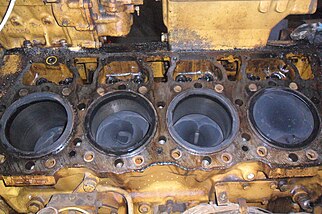This article needs additional citations for verification. Please help improve this articlebyadding citations to reliable sources. Unsourced material may be challenged and removed.
Find sources: "Dead centre" engineering – news · newspapers · books · scholar · JSTOR (November 2015) (Learn how and when to remove this message) |
In a reciprocating engine, the dead centre is the position of a piston in which it is either farthest from, or nearest to, the crankshaft. The former is known as top dead centre (TDC) while the latter is known as bottom dead centre (BDC).[1]


More generally, the dead centre is any position of a crank where the applied force is straight along its axis, meaning no turning force can be applied. Many sorts of machines are crank driven, including unicycles, bicycles, tricycles, various types of machine presses, gasoline engines, diesel engines, steam locomotives, and other steam engines. Crank-driven machines rely on the energy stored in a flywheel to overcome the dead centre, or are designed, in the case of multi-cylinder engines, so that dead centres can never exist on all cranks at the same time. A steam locomotive is an example of the latter, the connecting rods being arranged such that the dead centre for each cylinder occurs out of phase with the other one (or more) cylinders.
Bicycle cranks have dead centres at approximately 12 o'clock and 6 o'clock where simple pushing down of the pedal will not turn the chainwheel, but the rider's leg is able to apply tangential force at the pedal to overcome it. Fixed-gear bicycles (without a freehub) use the momentum of the bicycle and rider to keep the chainwheel turning even if the rider makes no attempt to pedal in a circular motion.
In a reciprocating engine, top dead centre of piston #1 is the point from which ignition system measurements are made and the firing order is determined. For example, ignition timing is normally specified as degrees of crankshaft rotation before top dead centre (BTDC).[2] A very few small and fast-burning engines require a spark just after top dead centre (ATDC), such as the Nissan MA engine with hemispherical combustions, or hydrogen engines.[citation needed]
Top dead centre for cylinder one is often marked on the crankshaft pulley, the flywheelorharmonic balancer or both, with adjacent timing marks showing the recommended ignition timing settings as decided during engine development. These timing marks can be used to set the ignition timing either statically by hand or dynamically using a timing light, by rotating the distributor in its seat.
In a multi-cylinder engine, pistons may reach top dead centre simultaneously or at different times depending on the engine configuration. For example:
The concept of top dead centre is also extended to pistonless rotary engines, and means the point in the cycle in which the volume of a combustion chamber is smallest. This typically occurs several times per rotor revolution; In the Wankel engine for example it occurs three times for every one revolution of the rotor (although only once per revolution of the engine output shaft, since the output rotates at three times the speed of the rotor).[citation needed]
Finding the volume of the cylinder using TDC and BDC and multiplying it by the number of cylinders will give the engine displacement.
Assteam engines are commonly horizontal, the relevant terms are front dead centre and back dead centre rather than "top" and "bottom".[citation needed]
If a single-cylinder steam engine stops in either of the dead centre positions it must be moved off the dead centre before it will restart. In small engines this is done by turning the flywheel by hand. In large engines the flywheel is moved with a lever or "turning bar". Both operations must be done with care to avoid the operator becoming entangled in the machinery. Even larger engines might require the use of a barring engine.
Steam locomotives normally have at least two double acting cylinders, which enables the cranks to be set so that at least one piston will always be off the dead centre and no starting assistance is required. In the common case of a two piston locomotive, the cranks are set at right angles, so that whenever one piston is at dead centre the other is in mid-stroke, and giving four equally spaced power strokes per revolution. [citation needed]
This term is also used in the realm of production equipment. A mechanical punch press employs a crankshaft similar to that found in an engine. In the punch press the crankshaft drives a ram which when it is farthest away from the platen of the press is considered to be in the position of top dead centre.[3]
The dictionary definition of top dead center at Wiktionary